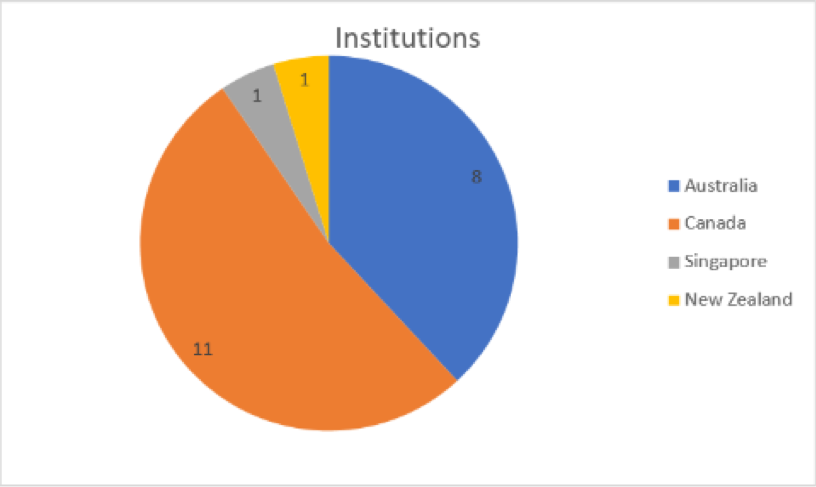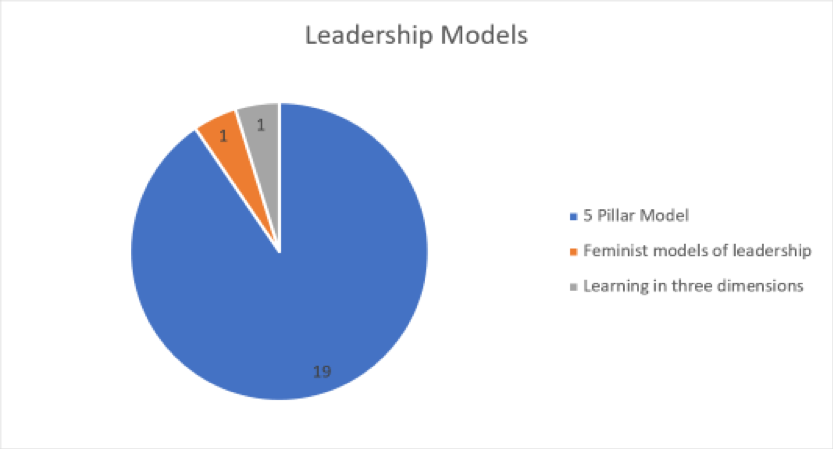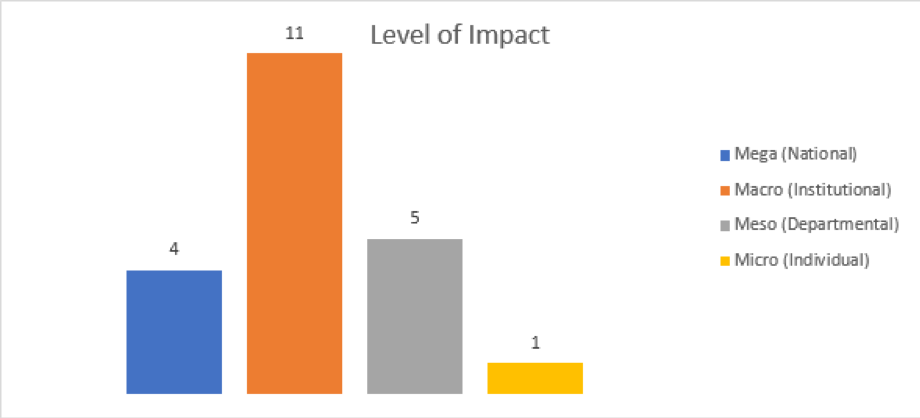Analysis
DATA COLLECTION
We issued a call in early 2019 for mini-case studies that outline educational leadership initiatives. The call for submission was distributed to the ISSOTL Scholarship of Leading Special Interest group, national networks such as Council Australian University Leaders in Learning and Teaching (CAULLT, https://www.caullt.edu.au), Australian Learning and Teaching Fellows (ALTF, https://altf.org), and via internal university list servers such as the President’s Teaching Academy at the University of Toronto (see Appendix). We collected 21 mini-case submissions that outlined an educational leadership initiative. Figure 2 illustrates the country of origin of the mini-cases, including: 11 mini-cases from Canadian institutions, 8 mini-cases from Australian institutions, 1 mini-case from an institution in New Zealand, and 1 mini-case from a Singaporean institution. Each mini-case study was vetted by two research assistants and stored in a OneDrive shared folder. Both the co-chairs and one research assistant reviewed and provided feedback on all draft submissions, then approved the final mini-case submissions.

Figure 2. Country of institution of the mini-case
DATA ANALYSIS
The analysis focused on the descriptions related to leadership position, leadership goals, leadership models, financial support, breadth of involvement of individuals and leadership impact.
Leadership positions held
The mini-cases indicate that educational leadership was driven from those that did and did not hold formal leadership titles. Figure 3 shows that there were 15 educational leaders who held formal leadership positions (those with official positions or titles with authority), while 6 mini-cases were identified as informal leaders (those without official positions or titles with authority). The leadership position of participants included Academic Directors (3), Centre Directors (5), Associate Deans (2), Associate Chairs (2), Deputy Vice-Chancellors (2) and Pro Vice-Chancellor (1). The role of formal leadership could be described as an enabler to provide financial sources, remove barriers and create an empowering climate for all individuals. Additionally, enabling cultures allow autonomy and empower interested individuals as informal leaders to construct shared initiatives through grassroots innovation.

Figure 3. Number of formal and informal leadership positions
Primary goals of the leadership initiative
Leadership goals can be derived from a range of paradigms. Lieff and Yammarino’s article (2017) provides a broader overview of such goals across a range of traditional and contemporary leadership paradigms. Most mini-cases had more than one goal. Figure 4 illustrates that the most common leadership goal focused on the delivery of outputs or wanting to achieve a desired change. However, more contemporary forms of leadership emerged that focused on generating trust and empowering others, enhancing leadership behavior and performance, and addressing shared and emergent issues.

Figure 4. Primary leadership goals
Leadership models applied
In terms of conceptualizing leadership practice, Figure 5 indicates that the 5-Pillar Model was used by the majority of participants to describe their initiative. Apart from the 5-Pillar Model, there were two different leadership models used to engage with academic staff and students respectively. One mini-case highlighted by a formal educational leader from a Centre for Teaching and Learning used a Feminist Model of Leadership to undertake a centre review in order to emphasize community, cooperation, and mutual benefit among academic staff within the institution. Another mini-case described an informal leader in a department who used the Learning in Three Dimensions Model to engage students in a particular course and develop social innovation and inclusive leadership.

Figure 5. Leadership models applied
Financial support received
The variety of financial sources was worthy of reporting, because funding can fulfill a vital role in supporting and valuing educational leadership. Information regarding the amount of and nature of financial support for leadership initiatives were, in many mini-cases, only implied or described in limited detail. Figure 6 illustrates that the majority of financial support stemmed from the institutions. There were six mini-cases that did not specify funding sources, so we were unable to ascertain whether any funding was received.

Engagement with stakeholders
To determine the breadth of stakeholder engagement we analysed who participants engaged with and for what purposes. Figure 7 indicates that participants mostly involved faculty members in their leadership initiatives to problem solve and take ownership of solutions. Educational leaders effectively integrated with learning and teaching units, collaborated with senior leadership within and across their faculties/departments and engaged students. They also reached out to critical networks, including industry partners, to build stronger connections. Functional experts and administrators were least drawn upon for exchange of ideas and support.

Figure 7. Engagement with stakeholders
Leadership impact
Leadership impact is measured against the four levels of leadership from Simmons and Taylor (2019). As described earlier, leadership can have an impact at the mega (national or international), macro (institutional), meso (faculty/department) and micro (classroom) levels. The scale and scope of leadership impact can exist within and across different levels. For example, an individual academic started at the micro level of activity and extended impact beyond their own unit and practice, which cultivated support and application at the meso and macro levels. Figure 8 shows the level of leadership impact. In some mini-cases the initiative may have created impact at the meso level and then created additional impact at the macro level. Our data are reported based on the highest level of impact.

Figure 8. Level of Leadership Impact